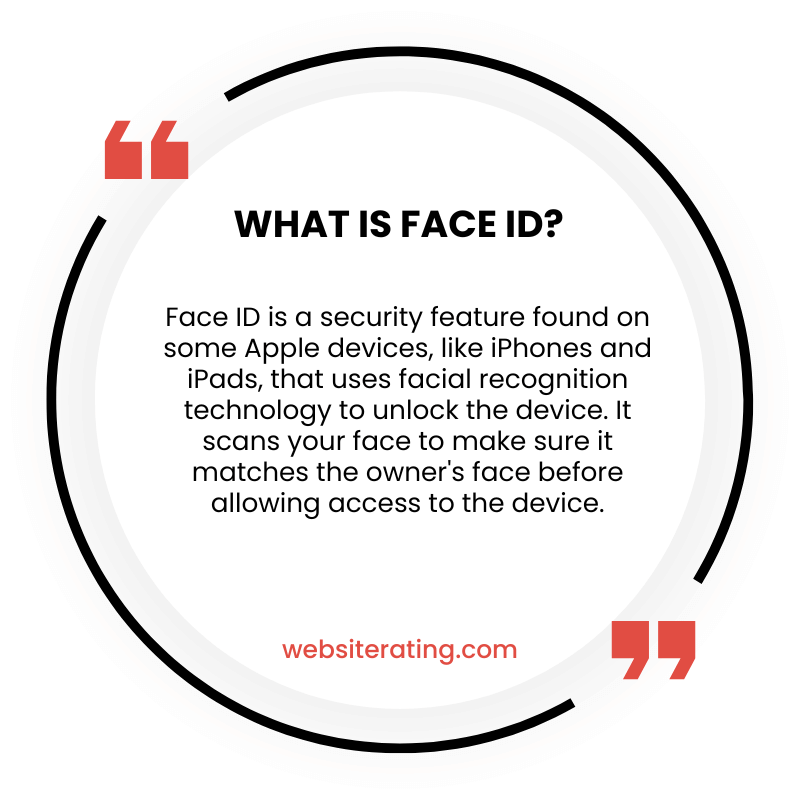Face ID is a form of biometric authentication used to verify the identity of users. It is becoming increasingly common as a way to access devices and services, including password managers. Here is an overview of Face ID technology, how it works, and its benefits for password management.

Face ID uses facial recognition technology to identify users by capturing an image of their face with an infrared camera. It then compares this image with one previously stored on the device or service in order to verify the user’s identity. The system also recognizes changes in facial features over time, such as those caused by aging or wearing glasses, which makes it more secure than other methods such as passwords or personal identification numbers (PINs).
What is Face ID?
Authentication technology that uses facial recognition can provide an additional layer of security for users. Face ID is a biometric authentication technology developed by Apple Inc. that allows users to unlock their devices, make payments and access secure applications using only their face as identification.
It utilizes the TrueDepth camera system on iPhones and iPads to scan the user’s face in order to identify them. The device creates a mathematical model of the face which is then compared to stored records each time the user attempts to authenticate with Face ID. To prevent unauthorized access, it requires that certain criteria such as distance between eyes, nose, mouth, shape of cheekbones and jawline must match before providing access.
Face ID also has the ability to recognize changes in appearance caused by wearing makeup or growing facial hair over time and will still be able to accurately recognize its registered user.
How Does Face ID Work?
The Current Section outlines the operational mechanics of a facial recognition authentication system.
Face ID is an authentication system that uses biometric features such as facial features to identify and authorize user access to apps, devices, and services. It utilizes the front-facing camera on Apple mobile devices and other compatible products to complete the face scan process. The device captures multiple images of the user’s face using its TrueDepth Camera System. During this process, it creates a mathematical representation of each unique facial feature which is then stored in a secure location within the device’s internal memory. Once authorized, this information can be used to securely unlock the device or authenticate access to third-party applications.
Face ID also has additional security measures in place which adds another layer of protection for users. For instance, if two different faces are detected at once when trying to gain access or if there is no match between the stored image and real-time face scan, then the request will be denied automatically without requiring any further action from the user. Moreover, it requires attention from both sides by verifying that only one person is looking at the screen before unlocking it thereby making it more difficult for anyone else to gain unauthorized access through Face ID technology.
Benefits of Using Face ID for Password Management
Facial recognition authentication systems, such as Face ID, provide users with a secure and convenient way of managing their passwords. By leveraging biometric data associated with an individual user’s face or fingerprint, Face ID eliminates the need to remember multiple passwords for various accounts. This makes it much easier for users to log into accounts quickly and securely without having to remember complex combinations of numbers and letters.
Additionally, this technology prevents malicious actors from using stolen credentials to gain access to personal information since they would also need physical access to the device in order to unlock it via facial recognition.
Furthermore, Face ID provides users with greater control over their digital identity by allowing them to authenticate themselves using only their own face rather than relying on others for assistance when accessing accounts. This allows individuals greater autonomy over their digital lives while maintaining a high level of security since no two faces are identical.
For all these reasons, Face ID is becoming increasingly popular among password managers and other online services that require strong authentication measures in order to protect user data.
Summary
The conclusion of this article is that Face ID technology offers a secure and convenient way for users to manage their passwords. It can be used as an alternative to traditional methods of authentication, such as passwords and two-factor authentication codes.
In addition, the use of facial recognition makes it easier for users to securely access their accounts without having to remember multiple passwords or worrying about forgetting their credentials.
Overall, Face ID provides an efficient and reliable means of securing one’s digital identity while ensuring convenience and peace of mind.
More reading
Face ID is a facial recognition system developed by Apple Inc. for the iPhone and iPad Pro. It allows biometric authentication for unlocking a device, making payments, accessing sensitive data, providing detailed facial expression tracking for Animoji, as well as six degrees of freedom (6DOF) head-tracking, eye-tracking, and other features. Face ID works by using sensors arrayed around the iPhone’s user-facing camera to scan a user’s face and, if the scan matches the data on file, perform actions like unlocking the phone or authorizing an Apple Pay transaction. (source: Wikipedia)
